The past, present, and future of human space travel
Ushasi Bhowmick
Space travel is a continuation of humankind’s deep longing to explore the unknown. We hope to look beyond the world we live in and experience the vastness of the universe.
Historically, humanity’s aspirations of space journey took form and evolved for a diverse set of reasons. Orbiting the Earth from far above offers limitless opportunities for improving earth observations, providing large-scale information on the climate, oceans, rivers, land, and air on Earth, and improving communication and surveillance. Going beyond Earth’s atmosphere also offers telescopes a stable platform to observe the universe better. These diverse motivations determine every aspect of the journey, from the design of the spacecraft, its payload, trajectory, and the final outcome.
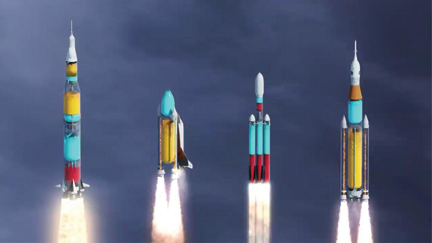
Source: Hazegrayart, https://www.youtube.com/watch?v=su9EVeHqizY
In the future, we may look at space as a place of accommodation for our ever-increasing population, or as a reservoir of resources for our accelerating technological demands.
The first step to an extra-terrestrial journey is to cross the atmospheric barrier. Earth’s gravity leads to an escape velocity of about 12 km/s. Such velocity cannot be attained all at once. Rockets do the trick by combustion of fuel, which generates gases that are expelled at high velocity, giving the rocket enough continuous and sustained thrust to pull out of the gravitational confines of the Earth. Naturally, such launches require a huge amount of fuel. Saturn V, which was the most powerful rocket ever launched, needed 2,076,545 kg of fuel to take people to the moon. However, most of the heavy stuff is used up in the launch, so what gets to space, called the payload, is actually much lighter.
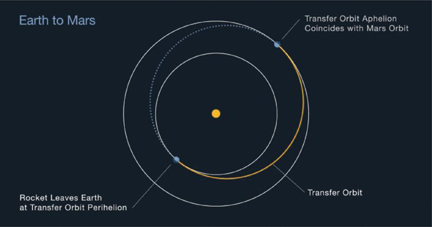
Source: Courtesy NASA/JPL-Caltech, https://solarsystem.nasa.gov/basics/chapter4-1/
Once in space, it is the destination that matters. Popular destinations today include the Earth’s orbit, moon, Mars, and most recently the sun. Space probes have also been sent further, such as the Vega missions to Halley’s comet, the Cassini probes to Saturn and so on.
The closest distance that we call space is the Earth’s orbit, which is home to more than 8000 satellites. These reach their orbit by hitching a ride on a rocket. Once they approach the correct altitude (height above the sea-level), smaller rockets fire the satellite into orbit.
For satellites orbiting elsewhere, such as around the moon, or Mars, we need a manoeuvring technique that utilizes the least amount of fuel. The neatest way to get to other planets is to use to our advantage, the fact that the Earth goes around the sun in an almost circular orbit. A satellite launched from Earth is first put into an orbit around the sun. After that, all we need is to adjust its rotation velocity. Conservation of angular momentum will take it closer, if we decrease velocity, or further, if we increase velocity, thus reaching a different planet. We can do even better. This journey of changing distances is made into an ellipse, where at one end we have the Earth’s orbit, and at the other, the orbit of the planet we are going to. Such systems are called Hohmann transfer orbits. These are highly fuel efficient, since the only time we need to start engines is when we switch orbits (Earth to transfer orbit, then transfer orbit to planet).
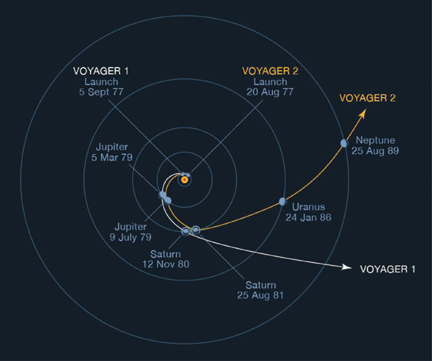
Source: NASA/JPL-Caltech, https://www.jpl.nasa.gov/edu/news/2018/12/18/then-there-were-two-voyager-2-reaches-interstellar-space/
For satellites bound to the moon’s orbit, the approach is similar. The satellite first goes around the Earth, gradually increasing the radius until it is closer to the moon. Then it goes to a transfer orbit that sends it to the lunar orbit. Such low energy transfers were used in the Chandrayaan missions to send satellites around the moon. Space probes like Voyager were sent in 1977 to explore deep space and used a chance alignment of all planets to obtain a ‘slingshot’ by gravity, saving mission time and fuel. The hope is to conserve as much of our resources as possible.
Sending machines to space is a simpler task, once we add humans to the mix, the problem becomes way more challenging. Human life on Earth is shielded in myriad ways, but in outer space, the body is exposed to some extreme environments. The human body is built to function in Earth’s gravity. The weightless environment in space can cause body functions to go haywire leading to loss of muscle, weakening of bones, disorientation of the body’s rhythmic cycles, etc. No longer protected by the ozone layer and the ionosphere, the body is exposed to harmful ionising radiation, which makes prolonged stay in space a high-risk zone for cancer. For a human mission, the stakes are much higher and we must send a fully functioning life-support system, with all basic needs such as food and water. This amounts to an increase in payload.
Yet, humans have been to space. The Apollo missions of the 1960s and 70s took astronauts to the moon. The International Space Station is a fully functioning permanent life support module in outer space, orbiting the Earth for over two decades now at an altitude of about 400 kilometres in what is known as the Low Earth Orbit. Astronauts routinely spend several months on the International Space Station conducting interesting experiments from its microgravity environment. We have also sent probes to the asteroids, the sun, other planets, and beyond the solar system itself.
So, what’s next?
The future edges into the realm of imagination.
The most gripping idea is the one to set up colonies on other planets, such as Mars and the moon. A living settlement on a different planet is a very challenging concept. We are talking about different atmospheres (sometimes hostile and very wispy), totally different gravity and different seasons. Some of these differences the human body will learn to adapt to, but these far-reaching colonies will have to be able to simulate the environment on Earth. We will need a self-sustaining system which can support human life.
This is the most active space research as of now, and the major problem is that there is no infrastructure in place to build such a system, but plans to build a lunar base and a Martian base have already been laid out.
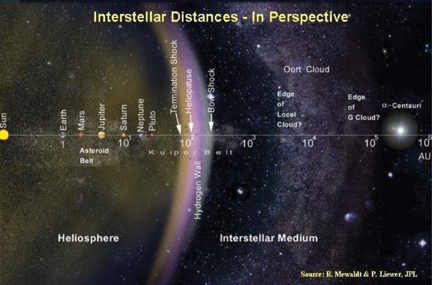
Source: NASA/JPL-Caltech, https://www.nasa.gov/centers/glenn/images/content/84498main_perspective.jpg
To go further, the two biggest roadblocks are time and fuel. The current means of propulsion uses chemical combustion to provide thrust, therefore to make a long interstellar journey possible we must utilize a vast amount of fuel, not to mention the speeds that we can obtain are not enough to reach other star systems within any reasonable time. Our nearest star system Proxima Centauri is 4.28 light years away which the spacecraft Voyager I will take 73000 years to reach. A manned trip to Mars will need more than 1000 tons of chemical propellant.
Newer ideas are slowly inching towards addressing these problems.
The nuclear motor is the most practical of all, instead of using chemical means of propulsion, we use a rocket powered by nuclear fission. In a nuclear thermal propulsion system, radioactive atoms like Uranium-235 split apart inside the reactor core. The energy released is used to heat a propellant such as liquid hydrogen to high temperature, which is sent through an exhaust to generate the thrust needed to power the spacecraft. Lighter gases make more efficient propellants. Chemical propulsion uses water vapour obtained from the combustion process, which makes a heavier gas than hydrogen. Thus, this is expected to be more than twice as efficient.
The risk factor here is that we need to protect the manned crew (if that’s the plan), or the equipment aboard from the hazardous nuclear waste the rocket engine will emit. Such was the case with the Russian nuclear-powered satellite Cosmos 954 launched in 1977. Within weeks of its launch, the satellite veered off-course and exploded, showering radioactive debris over a 400-mile radius in Canada. Since then, NASA has also tested certain prototypes such as the NERVA and the KIWI project, but no reactor has been sent to space yet.
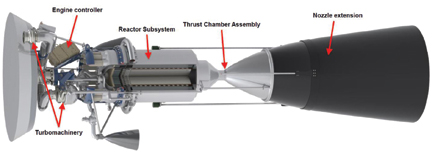
Source: NASA/JPL-Caltech, https://www1.grc.nasa.gov/research-and-engineering/nuclear-thermal-propulsion-systems/
A fusion reactor, on the other hand, is far safer. But a working fusion reactor on the ground itself is a work-in-progress. In theory, the idea is to build a magnetically confined plasma. A plasma is a hot, electrically charged gas, which is confined by spinning it round and round in a magnetic field. Such plasma provides an environment for nuclear fusion. The energy generated would be used to heat the propellant. Such a system, called a Tokamak, has been built on the ground, but its dimensions are far from being space-like. If realized, we could have a highly efficient system to power our future interstellar travel.
Another idea is the building of an ion thruster, which ionises a neutral gas (hopefully hydrogen), which is accelerated via an electric field to generate thrust. This leads to a significant reduction in the fuel required, so we can travel light. Since hydrogen is present in vast majority in all of the known universe, refuelling shouldn’t be a problem. The drawback in the current technologies is that such engines provide lower acceleration, which means that to achieve high speeds they have to work for a longer time. This isn’t good for launch in the Earth’s atmosphere, where we need to overcome gravity, but this shouldn’t be an issue in space if we’re up for a long journey, not to mention that the fuel used is inert and perfectly safe for everyone or everything aboard. Such a propulsion system has already been tested – NASA’s Deep Space 1, which used Xenon propellant to flyby a comet, or Ad Astra’s VASIMR, which uses ionised plasma to generate thrust and is currently under development.
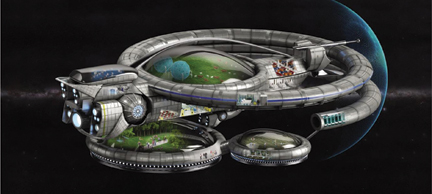
Source: http://www.sinelab.com/resources/illustration/PopularScience-Space-Ship.html
While the fuel problem may be simpler to overcome, the time problem is far more profound. Even if we manage to hit the speed of light, the distance to the nearest galaxy is 2.5 million light years away, and such a journey cannot be made in the span of a human lifetime. Science fiction toys with the ideas of generation ships and hibernation pods. A generation ship is a spacecraft capable of sustaining life onboard for a long period of time, housing several generations of humanity. Such a ship would have to have a closed ecosystem with a community large enough to maintain generations. Some simulations were in fact done in 1992 as project Biosphere 2. This was an attempt to scale down the Earth’s biosphere to such sizes that enable it to work in a spacecraft-like environment, but the attempt led to mixed results. While some theoretical groundwork is laid out for such kinds of spacecraft, the current infrastructure is far from its true realization.
A construction that actually gets us to a different planet in the future may be far more wondrous than what we can imagine right now. Maybe human lifespan wouldn’t even matter in the future, on the scale of interstellar exploration.
References
- https://ui.adsabs.harvard.edu/abs/2001DDA….32.0801K/abstract
- https://www.nasa.gov/directorates/spacetech/game_changing_development/Nuclear_Thermal_Propulsion_Deep_Space_Exploration
- https://spj.sciencemag.org/journals/space/2021/8067539/
- https://www.space.com/fusion-powered-spacecraft-could-launch-2028.html
- https://www.canada.ca/en/health-canada/services/health-risks-safety/radiation/radiological-nuclear-emergencies/previous-incidents-accidents/cosmos-954.html
- https://www.nasa.gov/centers/glenn/technology/Ion_Propulsion1.html
- https://solarsystem.nasa.gov/basics/chapter4-1/
The author is a post-graduate student of astronomy and astrophysics at the Indian Institute of Space Science and Technology, Thiruvananthapuram, Kerala. She can be reached at ushasibhowmick@gmail.com.
